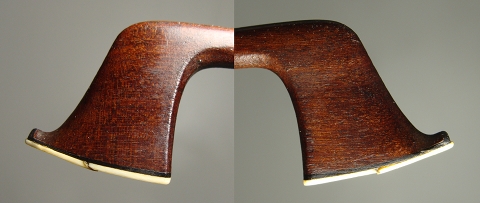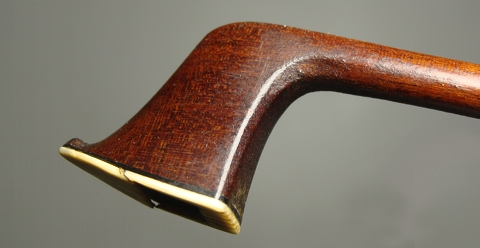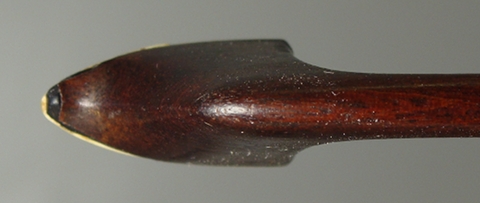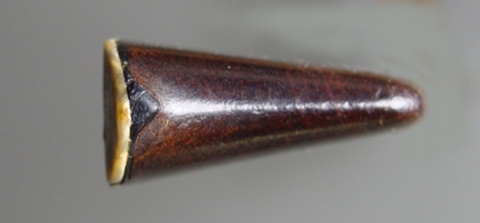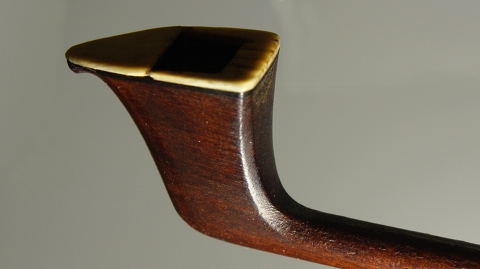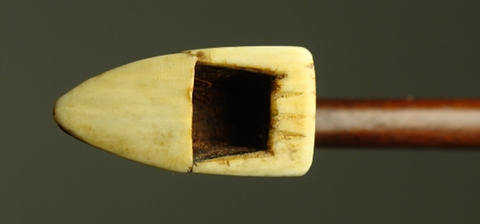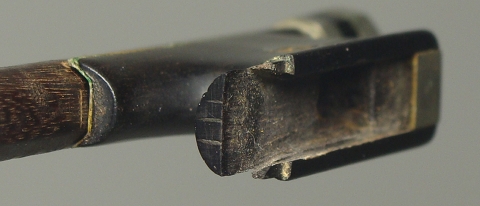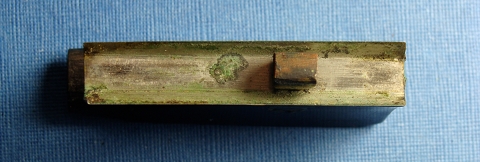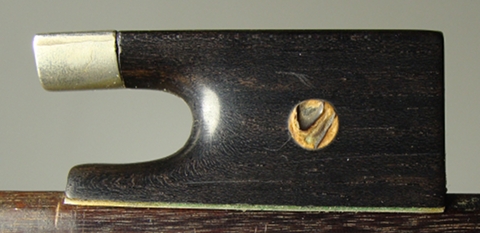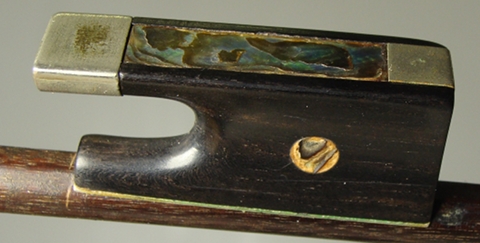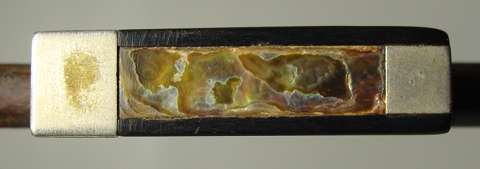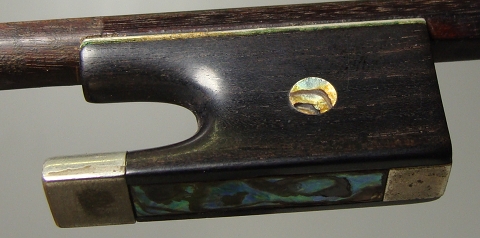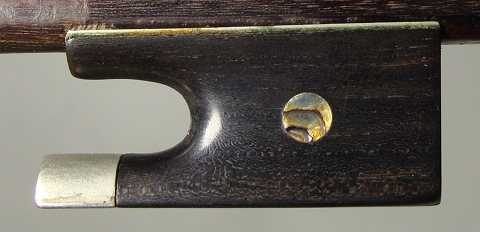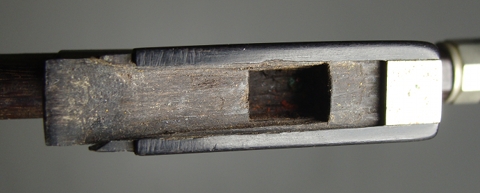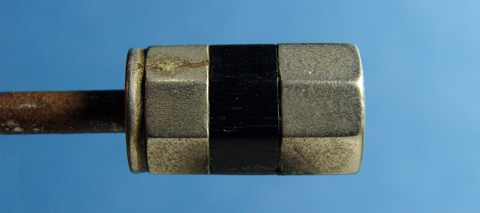BOW IN SEARCH OF ITS ORIGINIt often happens to have to deal with bows which are very difficult to identify. Usually even in desperate cases it is possible to establish the origin of the bow; except for this gentleman below – my black sheep – and apparently not only mine.
Violin Bow 1830/35 cc. presumed origin Mirecourt/Strasbourg Franco, an old orchestra friend showed this bow to me. He is a fan of pseudo antique markets and every now and then he phones me to tell me that he has just found a “wonderful instrument” and “you just wait and see”. Usually I am not inclined by such requests, but as I hadn't seen this friend for quite some years I agreed to meet. Then when we met, he showed me the violin immediately and as I suspected, it was of very little value. Then while he was putting away the violin away I noted two bows. The first one was completely without value; probably a Chinese bow made in the 80ies. The other one is the bow you see on the photo, and as you may have understood by now it has aroused considerable interest in me. The first thing to note is the quality of the wood; a pale brown wood of a medium density, and very strong. Similar material was used both in France and Germany in the initial period of bow making; the end of the 18th and the first half of the 19th century. Then another two things made me understand that the bow didn't come from a mass production of low standard. The varnish that was transparent and pulled very well, and furthermore the way that the craftsman had been able to pull out the mirroring of the medullary rays on the left side of the bow head. Both the quality of the shellac; a very pure one, as the way the craftsman has rotated the stick with the planer clearly shows that he has had a teacher, a very good teacher. The final certainty that confirmed my hypothesis, was a detail of which very few of my colleagues, especially Italian colleagues, pays attention; the curve. Besides being well executed and still intact – which isn't easy to find on a bow of more than 150 years – this bow was made according to the antique model; generally called the Peccatte Curve. Now, this mechanic was abandoned in the end of the fifties of the 19th century, because of the innovations introduced by F.N. Voirin, therefore our bow is definitely made before this date. Another detail that confirms the date is the length of the stick, which is 5 cm shorter than the modern ones.
The bow head has been well executed. The style is a bit unripe, which is probably due to a young craftsman. The bearing lines of the chamfer and the ivory tip are placed correctly in relation to each other; which shows a good teacher. You note it when observing the coherence between the size of the chamfer and the inclination of the wedge. The antique curves substantially has a rectangular profile creating a lightness problem, which the craftsmen tented to limit by opening up the chamfer a lot. In this case the craftsman made a small chamfer and he was therefore forced to act by sliding the wedge a lot - obtaining elegance. The bow head leaves clues to where it was made. The arrival of the stick has been left wide until the end which is typical to the France School, even though the inclination of the lateral sides of the stick are too accentuated; slightly atypical and obviously this affects on the geometry of the ivory tip. Another two details that brings the bow closer to France, is the way the chamfers of the wedge finish up, and the triangular geometry of the ivory tip; a distinctive of the French School, different from the German style, which is pentagonal. The chamfers of the wedge arrives unto the ivory tip in the French School, whereas the chamfers stops on the wood in the German School.
Another indication to the origin of the bow is the mortise of the tail. Whereas the German remains inscribed in the middle, it slightly overflows on the sides of the octagon on the French model.
These two photos shows us in which kind of workshop the bow was made. On the backside of the ivory tip, as on the top of the pallet of the frog you note three tiny engravings. These marks gives us the certainty of the originality of the bow, and let us understand that the bow was made in an expanded workshop. The marks were made in workshops with more than one worker to avoid confusion of the bows in production, and to simplify the quality control.
The frog was mounted in nickel silver, which could make one believe that the bow was made in a mass production in the beginning of the 20th century. It is though the use of nickel silver that makes it interesting. Drawn by the possibility to save on the cost of the material, Jean Dominique Adam, made bows, also ordered by Francois Lupot II, in the years from 1830 to 35. Soon the material started to show the first symptoms of imperfections; it oxidized and assumed a greenish colour. From that moment no one used nickel silver to make bows of high quality.
After having drawn my own conclusions I contacted colleagues for their opinion. Bow maker Mº Jean Narros reached the same conclusions as mine whereas another colleague meant that the bow had been made in France in the end of the 19th or the beginning of the 20th century – all three of us agreed on France as the origin. Convinced of the origin of the bow but eager for another opinion, I send some photos to Mº Raffin in Paris. He answered me that for his opinion the stick was German but he had doubts about the frog. I remembered Mº Raffin of the tiny engravings, and he quickly decided that the frog was made in Germany as well. I then send some photos to Mº Grunke in Berlin, and I asked him if he would recognize the bow as German and if it was possible to certificate it. He answered me that it wasn't possible because the bow wasn't German.
Therefore even though the bow hasn't been recognized, nor in France nor in Germany, at the time no craftsman outside these countries had the technical skills to make objects of this kind, so the origin of the bow has to be just one of these two countries. I will invite you to reflect on the words by a colleagues from Rue de Rome: “It is a shame to you that the bow is German, but a fortune to the musician that buys it. He gets a great object for not more than 6000 euros, if it had been French, he would have needed 30.000.” So long, Paolo
|
   |






